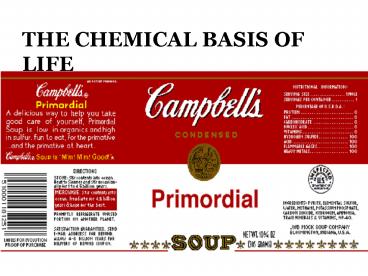THE CHEMICAL BASIS OF LIFE - PowerPoint PPT Presentation
1 / 36
Title:
THE CHEMICAL BASIS OF LIFE
Description:
the study of the chemical language of nature. He studies how insects communicate ... In order to understand the whole, biologists study the parts (reductionism) ... – PowerPoint PPT presentation
Number of Views:89
Avg rating:1.0/5.0
Title: THE CHEMICAL BASIS OF LIFE
1
THE CHEMICAL BASIS OF LIFE
2
Thomas Eisner and the Chemical Language of Nature
- Thomas Eisner pioneered chemical ecology
- the study of the chemical language of nature
- He studies how insects communicate via chemical
messages
3
- Rattlebox moths release a chemical that spiders
dont like
- This spider caught a rattlebox moth and then let
it go
4
(No Transcript)
5
(No Transcript)
6
2.1 The emergence of biological function starts
at the chemical level
ATOMS AND MOLECULES
- Everything an organism is and does depends on
chemistry - Chemistry is in turn dependent on the arrangement
of atoms in molecules - In order to understand the whole, biologists
study the parts (reductionism)
7
- Molecules and ecosystems are at opposite ends of
the biological hierarchy
- Each level of organization in the biological
hierarchy builds on the one below it - At each level, new properties emerge
8
D. Organ Flight muscle of a moth
- A biological hierarchy
Rattlebox moth
C. Cell and tissue Muscle cell within muscle
tissue
Myofibril (organelle)
B. Organelle Myofibril (found only in muscle
cells)
Myosin
Actin
Atom
Figure 2.1
A. Molecule Actin
9
2.2 Life requires about 25 chemical elements
- A chemical element is a substance that cannot be
broken down to other substances by ordinary
chemical means - About 25 different chemical elements are
essential to life
10
- Carbon, hydrogen, oxygen, and nitrogen make up
the bulk of living matter, but there are other
elements necessary for life
Table 2.2
11
(No Transcript)
12
- Goiters are caused by iodine deficiency
Figure 2.2
13
2.3 Elements can combine to form compounds
- Chemical elements combine in fixed ratios to form
compounds - Example sodium chlorine ? sodium chloride
14
Sodium
Chlorine
15
Sodium Chloride
16
2.4 Atoms consist of protons, neutrons, and
electrons
- The smallest particle of an element is an atom
- Different elements have different types of atoms
17
- An atom is made up of protons and neutrons
located in a central nucleus
- The nucleus is surrounded by electrons
2
Protons
Nucleus
2
Neutrons
2
Electrons
Figure 2.4A
A. Helium atom
18
- Each atom is held together by attractions between
the positively charged protons and negatively
charged electrons
- Neutrons are electrically neutral
6
Protons
Nucleus
6
Neutrons
6
Electrons
B. Carbon atom
Figure 2.4B
19
- Atoms of each element are distinguished by a
specific number of protons
- The number of neutrons may vary
- Variant forms of an element are called isotopes
- Some isotopes are radioactive
Table 2.4
20
2.5 Connection Radioactive isotopes can help or
harm us
- Radioactive isotopes can be useful tracers for
studying biological processes - PET scanners use radioactive isotopes to create
anatomical images
Figure 2.5B
Figure 2.5A
21
Hiroshima, Japan August 6th, 1945 815 am
22
Radon Levels in Georgia
23
- Radon is a colorless, odorless gas that is a
decay product of uranium and occurs naturally in
soil and rock. Radon gas has been identified as a
leading cause of lung cancer, second only to
cigarette smoking, and it is responsible for
thousands of deaths annually. Radon breaks down
into components called radon progeny, sometimes
called "radon daughters," which emit high-energy
alpha particles. These emissions raise the risk
of lung cancer. - The main source of high-level radon pollution in
buildings is surrounding uranium-containing soil
such as granite, shale, phosphate and
pitchblende.
http//www.lungusa.org/air/radon_factsheet99.html
24
(No Transcript)
25
2.6 Electron arrangement determines the chemical
properties of an atom
- Electrons are arranged in shells
- The outermost shell determines the chemical
properties of an atom - In most atoms, a full outer shell holds eight
electrons
26
- Atoms whose shells are not full tend to interact
with other atoms and gain, lose, or share
electrons
Outermost electron shell (can hold 8 electrons)
Electron
First electron shell (can hold 2 electrons)
HYDROGEN (H) Atomic number 1
CARBON (C) Atomic number 6
NITROGEN (N) Atomic number 7
OXYGEN (O) Atomic number 8
Figure 2.6
27
(No Transcript)
28
2.7 Ionic bonds are attractions between ions of
opposite charge
- When atoms gain or lose electrons, charged atoms
called ions are created - An electrical attraction between ions with
opposite charges results in an ionic bond
Na
Cl
Na
Cl
Na Sodium atom
Cl Chlorine atom
Na Sodium ion
Cl Chloride ion
Figure 2.7A
Sodium chloride (NaCl)
29
(No Transcript)
30
- Sodium and chloride ions bond to form sodium
chloride, common table salt
Na
Cl
Figure 2.7B
31
(No Transcript)
32
2.8 Covalent bonds, the sharing of electrons,
join atoms into molecules
- Some atoms share outer shell electrons with other
atoms, forming covalent bonds - Atoms joined together by covalent bonds form
molecules
33
- Molecules can be represented in many ways
Table 2.8
34
(No Transcript)
35
(No Transcript)
36
(No Transcript)






























